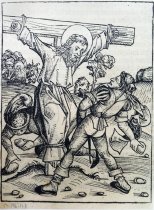Object Record
Images

Metadata
Catalog number |
P80 |
Artist |
Schedel, Hartmann |
Title |
St. Philip Being Stoned on the Cross, The Nuremberg Chronicle, folio CV, 1493 |
Date |
1493 |
Object Name |
Woodcut |
Description |
This woodcut is an illustrated page from "The Nuremburg Chronicle" showing the martyrdom of St. Philip, one of Jesus' apostles. It was printed then painted with watercolors and sold as a single print, probably to someone who could not afford the entire enormous book. This print was to be used during a time of private devotion following the practice of "devotio moderna" ("Devotio moderna" combined humanism and Christianity and pushed believers to pursue a personal relationship with Christ through private devotion and the reading of scripture), so that one could feel the pain, suffering, and sacrifice of the saint's last minutes on earth. One would observe the soldiers with the large stones in their hands ready to kill, and then look at the peaceful disciple and meditate on how one could emulate (imitatio) the follower of Christ Hartmann Schedel was a medical doctor and humanist born in Nuremberg, Germany in 1440. His extensive private library was among the most important of his time, not only because of the books themselves, but also because of its numerous prints and maps. Many of the writings and prints in Schedel's collection were tediously copied from other books by his own hand, before printed books were more readily in circulation. In 1493 he published the Chronicle, an illustrated world history that is divided into seven ages from the Creation of the universe to the Last Judgment. It was known as one of the largest printed books of that time, with over 1800 woodcuts, most of which were done by Michael Wolgemut, who was Nuremberg's leading artist in the 15th century. His woodcuts used advanced shading techniques never seen before. "The Nuremberg Chronicle" is more than a printed book: it is also an example of how the world of knowledge and art was changing. In its debt to Renaissance humanism, it shows a culture moving from medieval to modern. The Chronicle both refers to classical sources and borrows from other medieval chronicles. Also, during a time when few could read, it reached a wider audience with detailed illustrations and a simplified edition. Lauren Nuzzolo, in "SCHOLARS, EXPLORERS, PRIESTS, How the Renaissance Gave Us the Modern World," ex. cat. G -T M, Queens College, CUNY, February 2 - March 27, 2010, 16. |
Medium/Material |
Ink on paper |
Dimensions |
H-5.5 W-4.25 inches |
Search Terms |
Renaissance 16th century AD Portrait Figural Devotional Death Cross Figure Saint Biblical New Testament Religious Philip Germany Europe |
Exhibition and Publication History |
* "SCHOLARS, EXPLORERS, PRIESTS, How the Renaissance Gave Us the Modern World," Curated by James M. Saslow, G -T M, Queens College, CUNY, February 2 - March 27, 2010, # 16, ill. |
Culture |
German |

